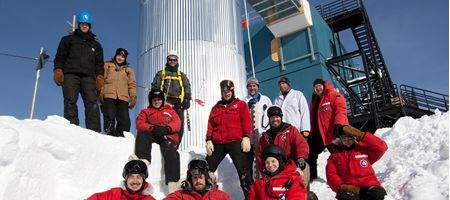The world’s largest neutrino observatory was completed on Saturday, with the installation of the final string of optical sensors in the IceCube Neutrino Observatory.

The telescope fills a cubic kilometer of deep Antarctic ice, and consists of 5,160 optical sensors embedded two kilometers below the National Science Foundation’s Amundsen-Scott South Pole Station.
“Since the 1970s we have dreamed of building a detector of this size, and we have spent 20 years working toward IceCube,” says principal investigator and UW-Madison physics professor Francis Halzen. “If the science to come brings half the excitement of completing this instrument, we have a bright future ahead.”
IceCube aims to investigate the properties of fundamental particles called neutrinos, tiny, nearly massless sub-atomic particles that pass undetected through most matter.
Some neutrinos come from the sun, while others come from cosmic rays interacting with the Earth’s atmosphere, and dramatic astronomical sources such as exploding stars in the Milky Way and distant galaxies.
IceCube’s sophisticated optical sensors, frozen into some of the purest ice on Earth, record the rare collisions between neutrinos and the water molecules of the ice.
The largest part of the IceCube detector is the ice itself. At these depths, it’s dark and optically ultratransparent, allowing the sensors to record the traces of particles from tiny flashes of blue light – called Cherenkov radiation – emitted after a high-energy neutrino strikes one of the water atoms in the ice.
Unusually, IceCube began collecting data while still under construction, and has been recording particle events since early 2005.
“Even in this challenging phase of the project, we published results on the search for dark matter and found an intriguing patterns in the arrival directions of cosmic rays,” says Halzen. “With the completion of IceCube, we are on our way to reaching a level of sensitivity that may allow us to see neutrinos from sources beyond the sun.”






